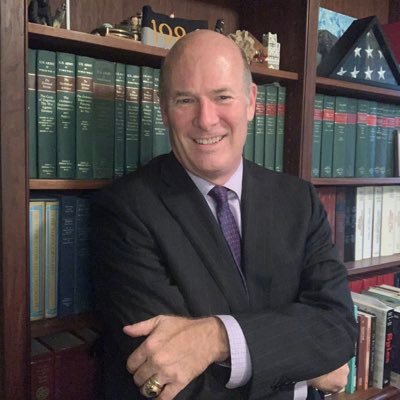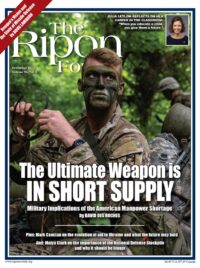
The United States has the greatest military capacity on the earth. Even the humiliating strategic defeats in Afghanistan and Iraq have not diminished this standing. Those were seen to be temporary missions away from our core mission of fighting a large-scale conventional war.
As for other nations, the Russian tactical and operational failure in Ukraine has pushed America’s closest rival significantly down the league table. And China thus far remains an unknown quantity; it certainly has a large number of forces and significant capability, but these forces are untested and could prove to be as inept on the battlefield as the once-vaunted Russian Army.
The current war in Ukraine is more akin to what America’s armed forces are structured for. Put simply, the wars of the last 20 years have been wars the U.S. had to fight; the war in the Ukraine is the type of war the U.S. military is built to fight. But there is a problem.
All the military services are challenged to recruit enough young Americans to fill the ranks of the Armed Forces. The Army only made 75 percent of its recruiting quota in fiscal year 2022; other services have also been strapped to meet their targets. The Army – as the biggest and most decisive of the military branches – is rightly the focus of this discussion. Each year, the Army must enlist the equivalent of 60,000 new soldiers — about one third of the entire Marine Corps. As the Army goes, so goes the rest of the services.
The Army only made 75 percent of its recruiting quota in fiscal year 2022; other services have also been strapped to meet their targets.
So why the shortfall? There is no shortage of speculation, but a few reasons stand out:
1) The military is increasingly divorced from society. Since the first round of post-Vietnam base reductions, the Army base infrastructure has steadily moved away from cities and into more remote areas. There is no major Army base in the Northeast save remote Fort Drum, New York, which is closer to Ottawa than to Buffalo, Boston, or New York City. Major Army bases are in Manhattan, Kansas not Manhattan, New York. As the Army recedes from society, society recedes from the Army – service tends to become a family tradition, and that tradition becomes centered around a shrinking number of rural bases. This is a half-century long trend.
2) There is a persistent social bias against military service in America. American thinking on its Army is bifurcated. While Americans respect their military and hold soldiers in high regard, they often feel that military service – particularly in peacetime – is something only suited for those who are unable to find other employment. It’s a trope among servicemembers that when they meet someone they will hear, “I would have served but..” with the “but” boiling down to “I thought I was too good.” The military is still viewed as the employer of last resort, and enlisted service particularly is not regarded as a career. Billy Joel managed to tap into these societal prejudices and paint a concise picture of dead-end loser-dom in just two couplets when he wrote: “Davy, who’s still in the Navy, and probably will be for life.
3) Employment is closely related to military recruitment. There is a nation-wide surfeit of jobs, and decades of recruiting experience shows high unemployment is usually good for recruiting, and low unemployment bad. The military life is challenging. See #2 above.
4) The relative value of traditional incentives to military service (such as paid college and free health care) is eroding. Over the last few decades, free access to college and to health care has moved towards becoming a universal right. In the past, these were major attractions to military service. If you can go to college and have your loans forgiven without ever having a drill sergeant yell at you, why wouldn’t you?

5) The pool of eligible Americans is shrinking. To serve in the military, a young American has to be relatively physically fit, not have a history of drug abuse, and not have an emotional or mental health condition. These standards were devised in a different era for a different society. Now, obesity is rampant in America, marijuana (and other drugs) are socially accepted and increasingly legal. Even before the stress of the pandemic and its associated lockdowns, there was an explosion in the diagnosis and pharmaceutical treatment of various behavior disorders among children and teenagers in the U.S. Unfortunately, these conditions can be disqualifying for military service; less than one-in-four Americans in the target age group are eligible for service. This is not solely a military problem, but rather a comprehensive whole-of-society failure and no less than a national disgrace. And finally…
Less than one-in-four Americans in the target age group are eligible for service. This is not solely a military problem, but rather a comprehensive whole-of-society failure and no less than a national disgrace.
6) The politicization of the military is a real thing, but it means different things to different people. Some in America have portrayed the military as an incubator of white supremacists, while others have portrayed it as a social experimentation lab for unresolved issues such as abortion and various gender issues. What can’t be debated is that America’s military reflects both the strengths and divides of American society. But these narratives – regardless of political viewpoint – are not helpful when an 18-year-old is trying to decide if he or she should enlist or attend college. The military has been invoked by all sides in the culture wars. When two elephants fight, the grass suffers most. Our military has been the grass.
The reasons for the problem are myriad. So how do we fix them?
Each of the causes I cite has a different solution, and some are easier than others. At a minimum, there should two reviews: one on eligibility for military service (with an eye towards updating recruitment standards to reflect modern conditions) and—more controversially – another to look at federal benefits associated with service (to ensure military benefits outweigh universal benefits).
But at the end of the day American society determines what sort of military America has. We are not Prussians. We need to honestly look at who we are and what we want. Our Army reflects us. We need to take steps to ensure we like what we see.
David Des Roches is an associate professor at the Near East South Asia Center for Security Studies at the National Defense University. He previously served in the Office of the Secretary of Defense as the DoD Liaison to the Department of Homeland Security. An Airborne Ranger in the Army Reserve, he was awarded the Bronze Star for service in Afghanistan. The opinions expressed here are his own.




